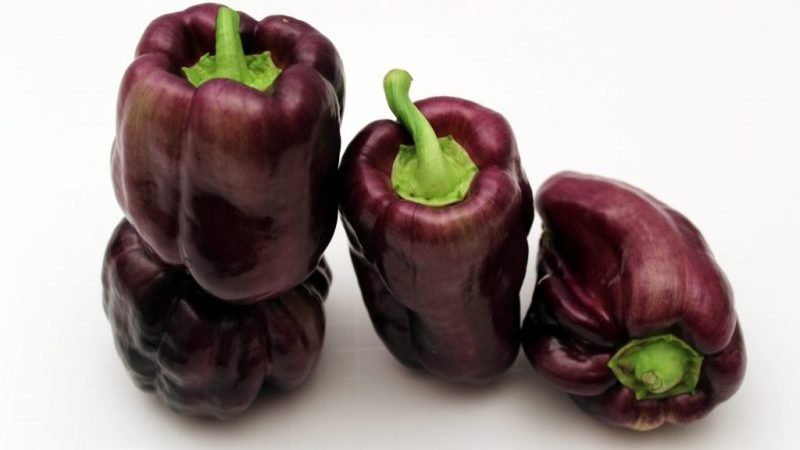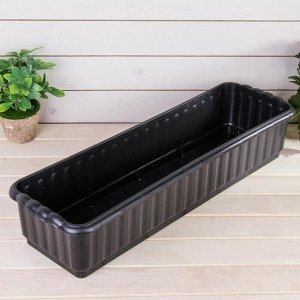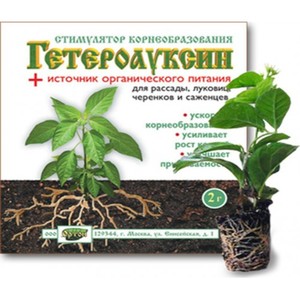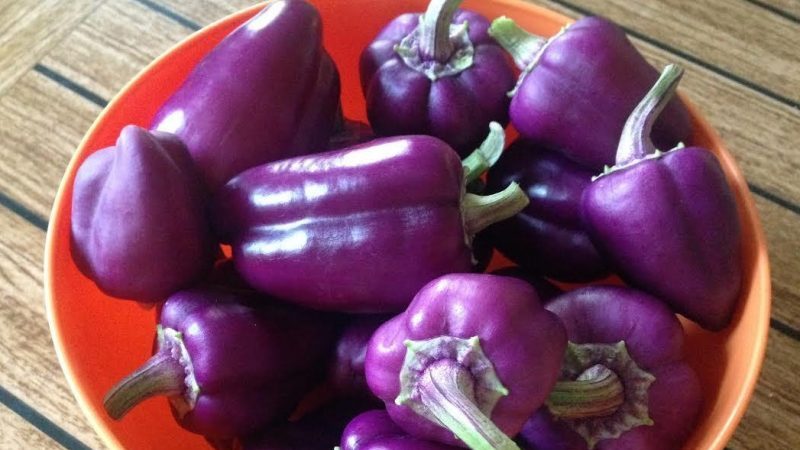Unusual variety with purple fruits - Big Papa pepper and the nuances of its cultivation
Big daddy pepper attracts gardeners with its original appearance: glossy purple fruits look beautiful and decorate any dining table. The vegetable is rich in vitamins A and C, is versatile in use and has a long shelf life, so many people dream of growing Big Dad's Bulgarian pepper on their site.
In the article, we will consider how to get a rich harvest and learn the secrets of growing this variety.
The content of the article
What kind of pepper is this
Big daddy is suitable for growing in central Russia. Pepper is planted both in open beds and under film shelters. It is unpretentious in care, has a high and stable yield.
Characteristics and description of the variety
The bushes of the variety are undersized, the maximum height is 0.5 m.The leaves are small, rounded, with a small purple tint... The variety is early maturing, ripens 90-100 days after planting.

Fruit characteristics and yield
Fruits are small, conical. Vegetable weight varies from 100 to 120 g, diameter is about 10-15 cm. The walls are of average thickness 5-7 mm. The color is dark cherry, the skin is smooth. The pulp is juicy and sweet in taste, so the pepper is actively used in cooking. With proper care, gardeners from 1 sq. m harvested about 7 kg of delicious and beautiful fruits.
Interesting! 100 g of bell pepper contains only 25 kcal. The vegetable is rich in fiber, iodine, fluoride and iron. Vitamins of group B, which are found in large quantities in sweet peppers, help fight stress, prevent insomnia, and relieve fatigue. Vitamins P and C strengthen the walls of blood vessels and activate the liver.
Preparation for growing
Preparation for growing Big Papa bell pepper consists of several procedures. Let's consider each in detail:
- Seed preparation. It is recommended to purchase seeds only in trusted stores, paying attention to the shelf life of the material and the integrity of the packaging. The seeds are disinfected at home by heating: they are placed on a baking sheet and put into the oven for 40 minutes at a temperature of 180 ° C. Another method of disinfection is soaking in a solution of succinic or boric acid. Disinfection destroys pathogenic microflora on the seed surface and protects the seed from disease.
- Preparing the beds in the garden. Pepper prefers sunny and loose beds. At the end of October, the earth is carefully dug up, getting rid of debris and plant residues. They are fed with peat or humus, per 1 sq. m consume 1.5 liters of fertilizer. With the arrival of spring, the soil is dug up again, getting rid of foliage and large lumps. The beds are leveled with a rake, watered with an infusion of liquid mullein.
The best precursors for planting peppers are onions, herbs, or legumes. It is not recommended to plant peppers after tomatoes or potatoes. Compliance with the rules of crop rotation prevents the appearance of weeds and pests.
Growing seedlings
Seedling method accelerates adaptation to adverse weather conditions. Prepare it 50 days before planting seeds in the ground.
Planting pepper

Peppers are planted in any convenient container. These can be cut plastic bottles, tight bags, and even eggshells. An excellent container for Big Papa peppers are seedling boxes with drainage holes. They are made of wood or plastic.In the store, it is not difficult to find the size of the drawer that is suitable for a particular window sill. It is convenient to care for the sprouts in the box, all the seedlings are nearby. If necessary, transfer all the peppers to another place. The recommended drawer height is at least 8 cm.
The distance between the seedlings should be at least 7 cm. Small grooves 1 cm deep are made in the soil with a pencil. 2-3 disinfected seeds are placed in each hole, sprinkled with earth on top and watered with warm water. To create a greenhouse effect, the seedlings are covered with polyethylene or thin glass. The shelter is removed after 2 weeks, when the first shoots appear.
Seedling care

Sweet pepper seedlings need warmth and sunlight, so the best place for them is a windowsill. Care consists of timely watering and fertilization. Water the seedlings once every five days, it is recommended to use warm water from the filter.
Cold tap water increases the risk of dangerous germs growing. Fertilize the peppers 15 days after planting. The first feeding is liquid organic matter, such as bird droppings or mullein. The next time the seedlings are fed in another two weeks. To accelerate growth, use stimulants - drugs "Kornevin" or "Heteroauxin".
Important! If the seedlings grow in small cups or pots, two weeks after planting they will dive, that is, they are planted in a larger container. A pick gives the roots more room for growth and development. Sprouts are carefully placed in a container with earth, sprinkled on all sides and slapped.
Planting in the garden and further care
10 days before planting in the garden, the number of watering is reduced, and a week before it is completely stopped. You can understand that the peppers are ready for planting by a characteristic feature: the sprouts have 8-11 leaves and developed flowers. The best time for the procedure is early morning or evening when there is no sun. The optimal distance between the bushes is 50 cm - a thickened planting will lead to the development of diseases. Seedlings are watered abundantly, each bush is carefully removed from the container and placed in a prepared hole.
Regular and correct watering is the basis of any plant care. The water temperature should be at least + 20 ° C, the beds are moistened once every 5-7 days. About 1.5 liters of water are consumed per bush. The jet is directed directly under the root, bypassing the stems and leaves. This protects the bushes from fungi and viruses. Some summer residents install a drip irrigation system on their site. It is convenient because water flows directly into the root system, while the moisture consumption is several times less than with manual irrigation.
It is impossible to grow a rich harvest without timely fertilizing and fertilization. The procedure is carried out two weeks after disembarkation and then with an interval of 2-3 weeks.
To fertilize Big Papa pepper use:
- dry wood ash based solution;
- liquid mullein, urea, bird droppings;
- ammonium nitrate;
- superphosphate.
Features of cultivation and possible difficulties
Growing in a greenhouse has its own rules. Before disembarking, the walls of the structure are wiped with a solution based on potassium permanganate in order to destroy dangerous microbes... They begin to form the plant as soon as the stems branch out. Only the powerful and strong are left, and the weak are removed.
It is recommended to keep track of the amount of dressings applied. If a leaves acquired a yellow tint and became dry, which means that the gardener applied too much mineral fertilizers. If the plant is gaining growth and green mass, but does not bloom, this indicates an excess of nitrogen; dry and weak stems - an excess of phosphorus. Plentiful watering with warm water and dusting the bushes with wood ash will help to correct the situation.
Typical diseases and pests
If the rules of crop rotation are not followed, a wireworm appears in the beds with pepper. The pest lives underground, feeds on the roots of the plant, which is why it stops growing.If measures are not taken in time, then the bush itself begins to wither, and the fruits deform. To get rid of a thick brown worm, professional means "Maxim" or "Oksikhom" help.
In addition to wireworm, pepper is negatively affected by:
- Colorado beetles, the reason for the appearance of which lies in the contaminated soil. Beetles and their larvae can destroy the entire crop. Get rid of them with the "Typhoon" drug.

- Thrips appear at the stage of formation of bushes. They feed on plant sap and nectar, depriving them of nutrients for further development. For prophylaxis, they are sprayed with Bordeaux liquid.
- Whiteflies- miniature white midges - gather on leaves in whole flocks. In the fight against whitefly, spraying based on milk and iodine helps.
Late blight is especially dangerous. The fungus appears due to excessive heat, temperature extremes, improper watering. Late blight manifests itself in the form of yellow and brown spots on the leaves and stem. The fungus is dangerous both for open ground and for greenhouses. In the fight against late blight, spraying with manganese or watering with water with wood ash is used.
Advantages and disadvantages of the variety

The advantages of the Big Papa variety include sweet and juicy taste, firm pulp, attractive and original appearance. Due to its small size, the pepper is great for making stuffed snacks, it is used as an ingredient for winter preparations and pickles. They grow crops in the open ground or in greenhouses; the vegetable does not require special knowledge and skills to care for.
Interesting! Bulgarian pepper goes well with meat, fish and poultry, harmonizes with the taste of other vegetables. Especially original taste is obtained if you grill Big Papa pepper. The vegetable will acquire a beautiful roasted appearance and a piquant aroma. You can cook pepper both in the country and at home, on a home grill. Aromatic spices and herbs, as well as balsamic or wine vinegar, will help add zest.
Minus: Big daddy is suitable for growing only in central Russia. In the Urals and Siberia, pepper shows a low yield. In addition, the vegetable has an average immunity to diseases and pests.
Reviews
What do other gardeners say about Big Daddy pepper? Here are a few reviews from popular Internet forums.
Alisa, Volgograd: «I love everything unusual, so I decided to plant Big Dad pepper. The harvest exceeded all my expectations! I collected 10 kg of pepper from the garden! The beautiful dark cherry vegetable was enjoyed by the whole family. "
Maria, Oryol: “I have planted the Big Papa variety for the third time. I prefer to grow in a greenhouse to protect from bad weather. The variety does not cause trouble, you do not need to tie or pinch bushes. I use the harvest to prepare salads and side dishes, I freeze the remaining peppers for the winter. "
Pavel, Penza: “On the recommendation of a neighbor, Big Dad planted it last year. Planted with seedlings, observed all sowing dates. However, in the garden, the peppers took root badly, slowly gaining weight and color. I was disappointed because I was hoping for a different result. "
Conclusion
Big papa pepper is loved by both novice gardeners and experienced gardeners. The vegetable is planted with seedlings, which are prepared in 1-1.5 months. The best predecessors for the variety are cabbage or greens. Pepper does not cause trouble in leaving, the main thing is to water and fertilize the beds on time.
Harvested when the peppers become elastic, acquire a dark cherry hue. The fruits are medium-sized, fleshy and have a glossy surface. Fresh vegetables are used, as well as for preparing snacks, salads and winter preparations.